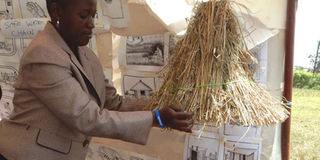3.5 million Ugandans defecate in the open

One of the officials who attended the World Toilet Day exhibition in Amuria District looks at the protype of a pit latrine that government plans to enforce, especially in much of rural Uganda. More than 10 million people have not toilets, according to government. PHOTO BY RICHARD OTIM
What you need to know:
Expensive. As a result of open defecation, government spends more than Shs110b treating sanitation-related diseases.
Amuria:
At least 3.5 million (10 per cent) of Ugandans still defecate in the open, which calls for urgent government action to undertake a countrywide effort to mobilise communities against the practice.
Dr Elioda Tumwesigye, the State Minister for Health in charge of General Duties, on Wednesday said this is costing government $41m (about Shs110b) per year in treating diseases related to poor sanitation including diarrhea and dysentery.
He said an estimated Shs390b was lost in 2011 alone as a result of lack of good sanitation facilities at household level and public health facilities.
“Government is soon coming out strongly on this (open defecation). Plans to erect public toilets along most of the highways across the country are also underway,” he said.
Speaking at the commemoration of the World Toilet Day in Amuria, Mr Tumwesigye said 10 million Ugandans still lack access to safe water while some 200,000 die of diarrhea every year.
Proper fecal disposal
“This is all because many of our people in the villages do not utilise proper fecal disposal practices. All local governments are now directed to come up with by-laws to enforce proper defecation,” said Mr Tumwesigye.
The country representative of Water Aid, Mr Peter Okubal, said his organisation is currently supporting the Parliamnetray Forum for Water, Sanitation and Hygiene to enable push for increased funding for better sanitation services.
Amuria District water officer, Mr Patrick Obaate said latrine coverage that had previously been aggravated by prolonged confinement of paersons in IDP camps across the district had improved from 45 per cent to about 80 per cent between 2009 and 2014.




